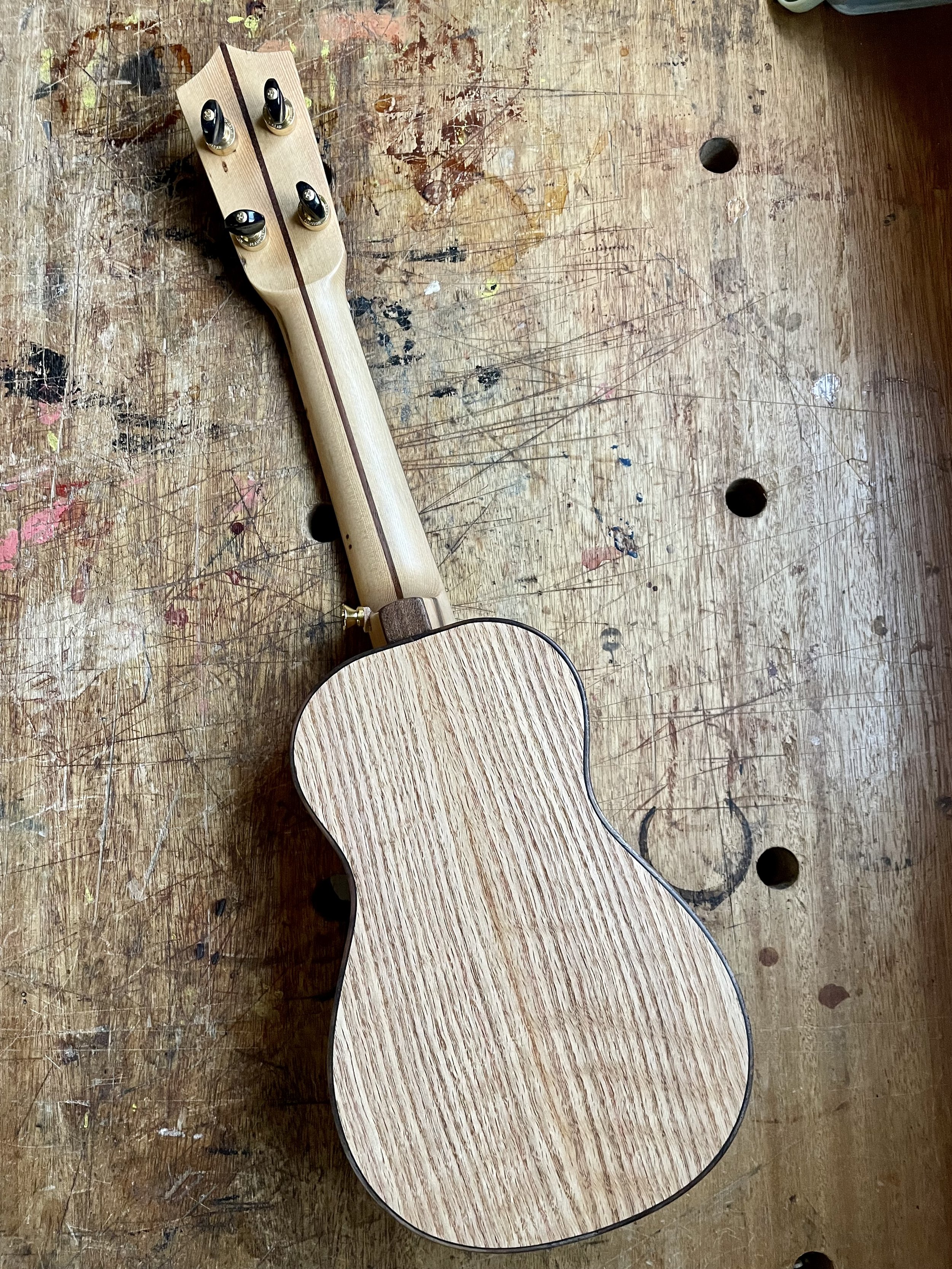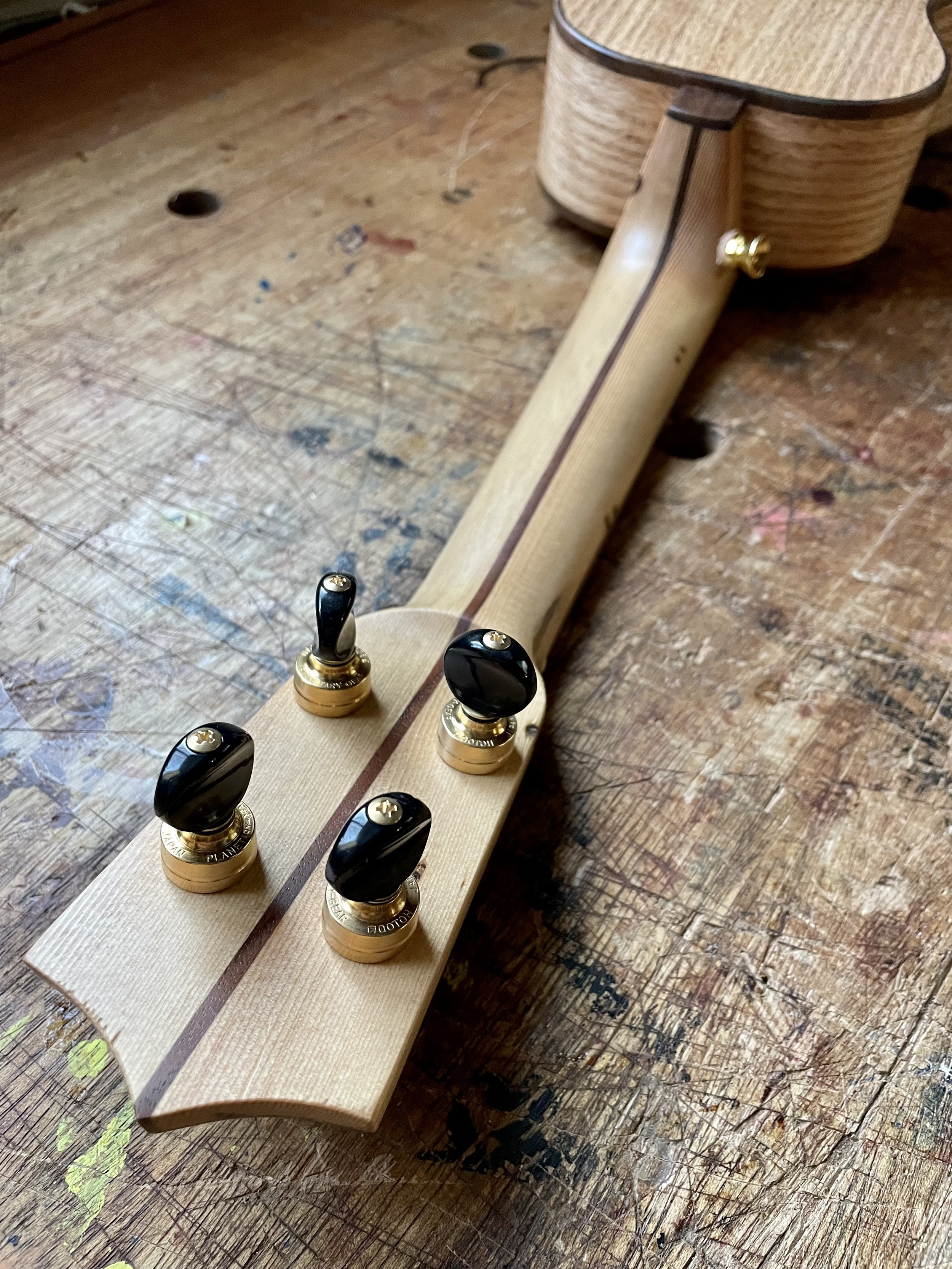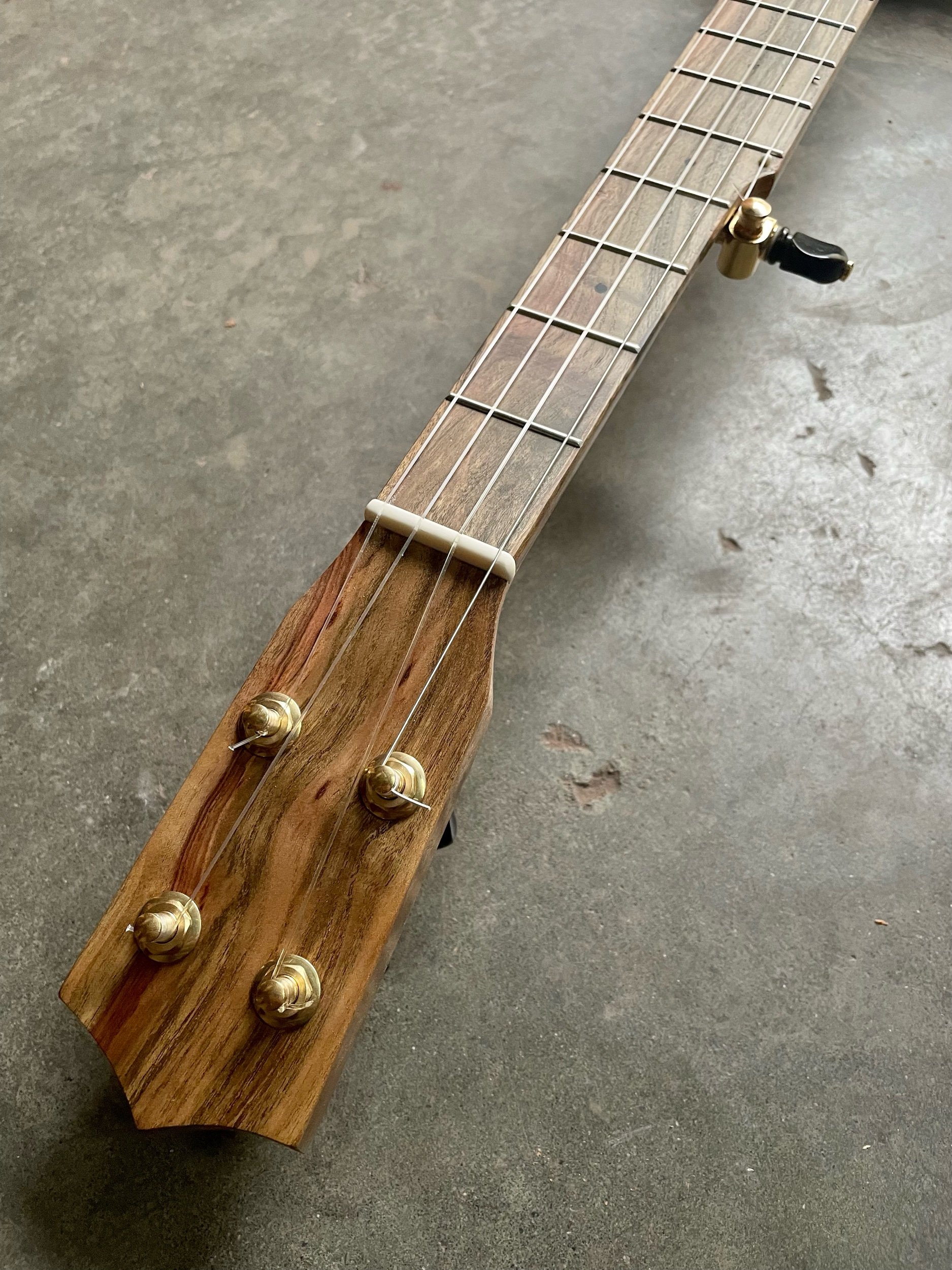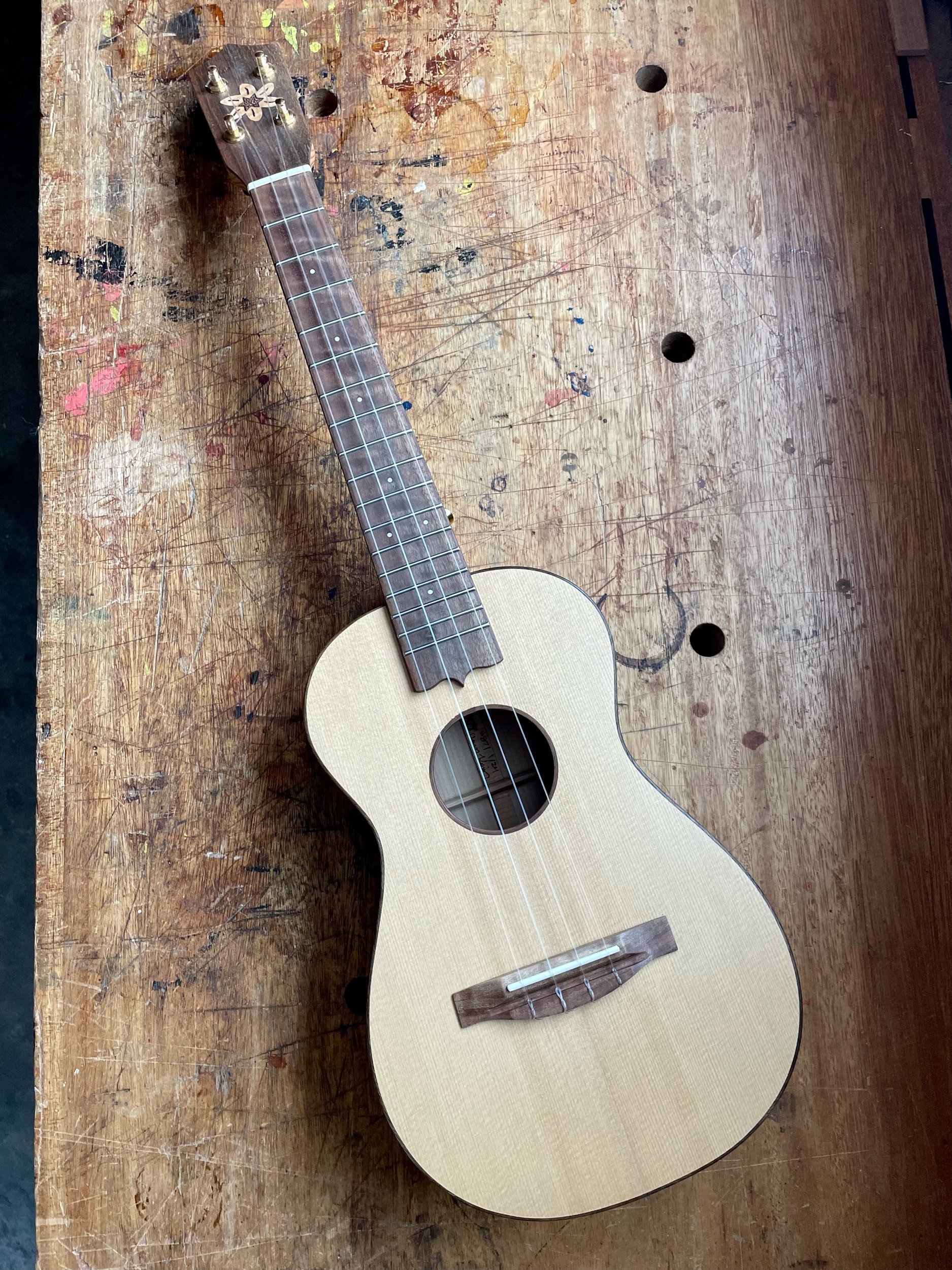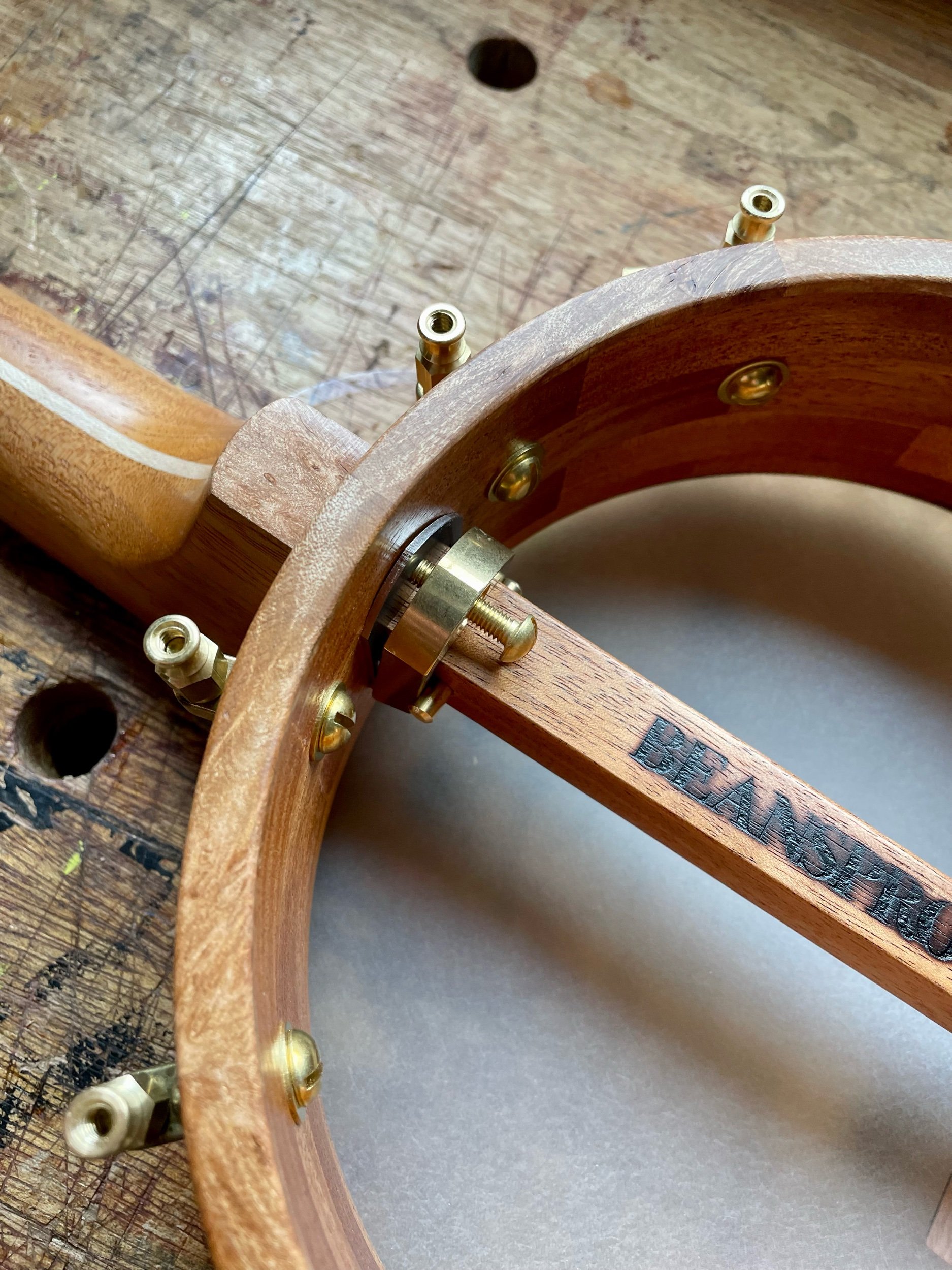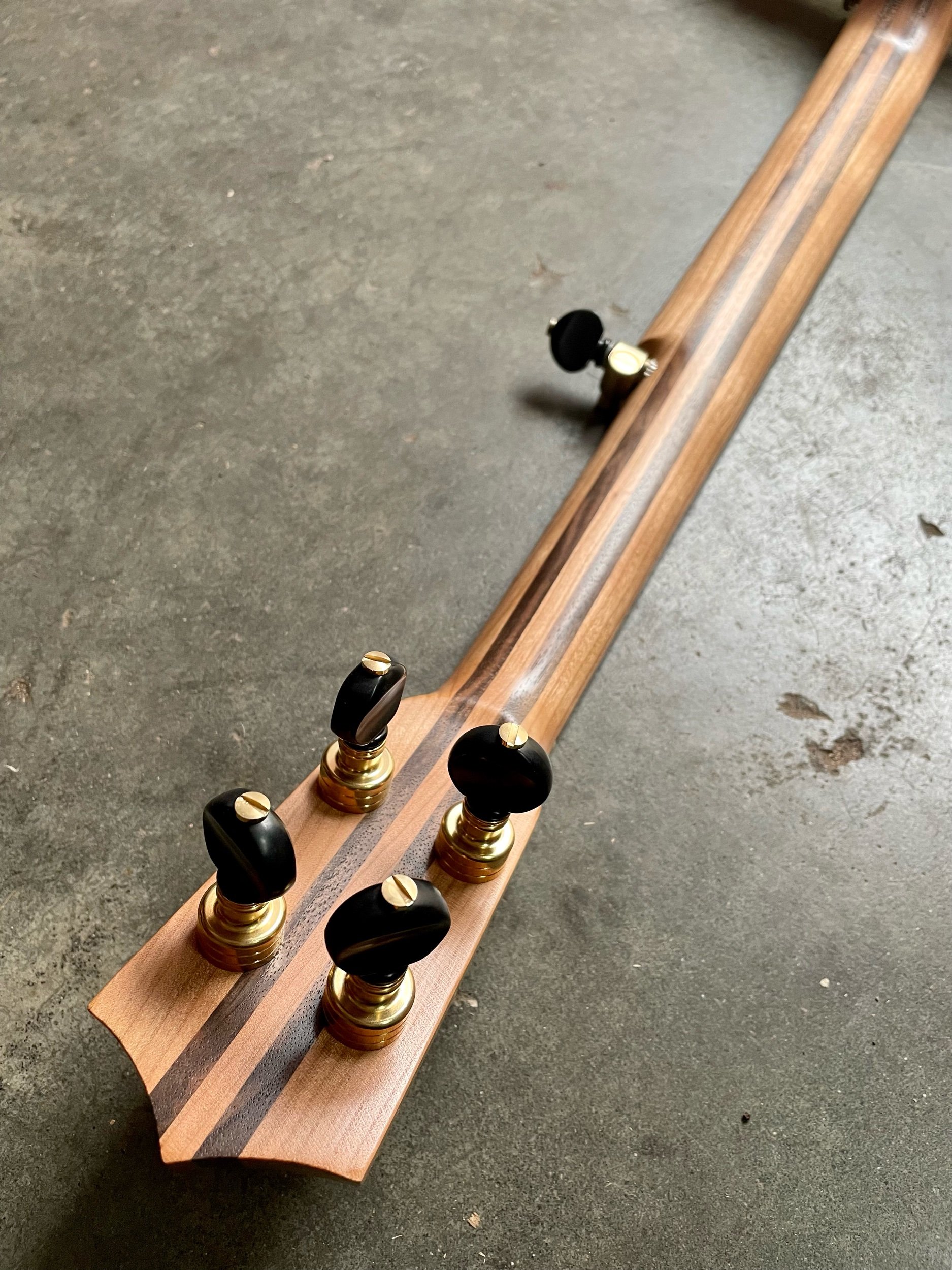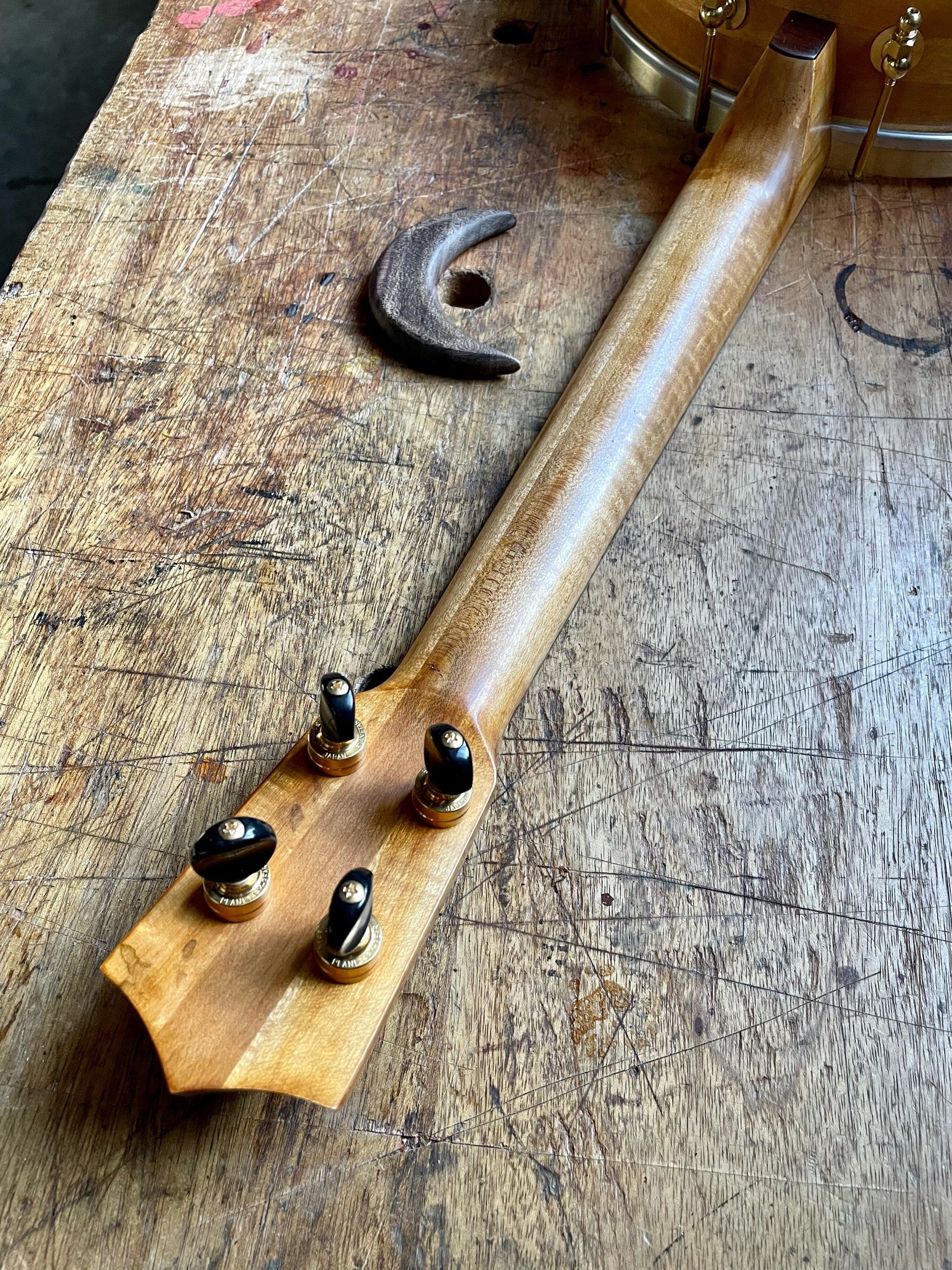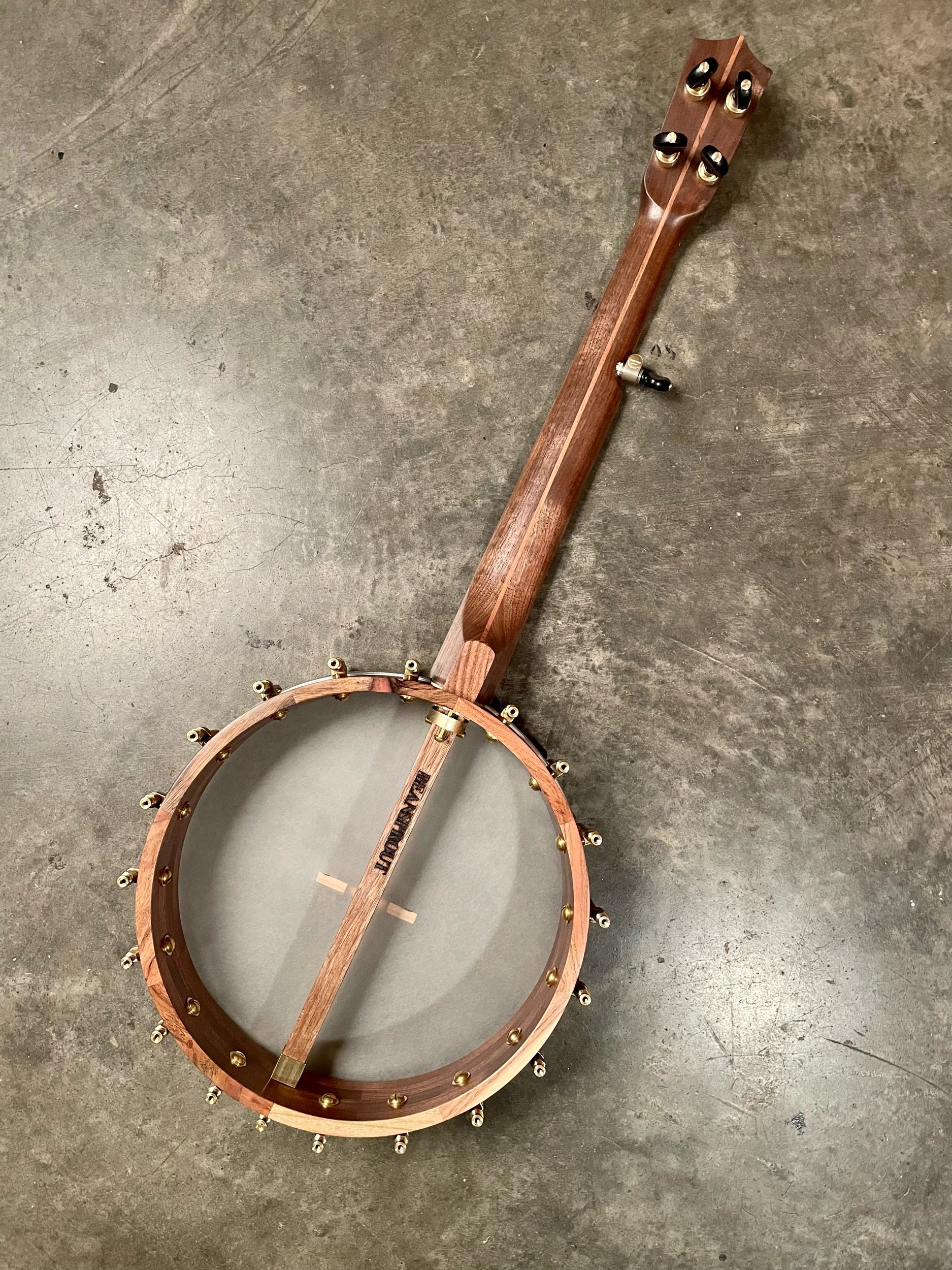I’ve been studying so many early Hawaiian instruments the past two years that my own designs started to look strange to me. It was time to reclaim my soprano in my own mind and Jerry was there with an order at the right time. The top is Western Red Cedar cut from a fence post in Otis, OR. The Oak back and sides are from the Carpenter Ant stash in Portland, originally milled for clock cases. I have plenty of it and I love how it looks and sounds. The Fir neck is salvaged from an old building, full of nail holes and a big knot. Everything else is local Walnut. It’s lightweight, loud and old sounding. It is full of different textures, visually, sonically and to the touch.
#881- Port Orford Cedar and Curly Walnut Tenor Ukulele
Check out that curly Walnut! It’s from a local tree that my friend Chris milled and it looks and sounds fantastic. I paired it with a striped Port Orford Cedar top from the Oregon coast and lots of fancy Pistachio from California orchards. It has a full, loud and balanced sound, suitable for any style.
“Hello Aaron & Nicole,
I received my tenor ukulele late this afternoon, and I’m thrilled to pieces with it. It’s so beautiful and I love the sound. Looks like I’ll be up pretty late bonding with it into the wee hours .
I’ll be looking forward to my baritone next, and know it’ll be an awesome instrument as well.
-C. S. ”
#877- Port Orford Cedar and Curly Myrtle Scout Ukulele
Yeah! Another scout ukulele! Crafted from the scrap bin and ready to make music. Port Orford Cedar top, curly Myrtle back and sides, Cedar neck and Walnut everything else. It has some bird’s foot purfling on the top to dress it up a bit. It’s off to the Scout email list right now.
“Thank you so much for sending me the scout. I love the birdsfoot purfling and this little uke has such a nice warm sound! The backpack case is nearly as impressive as the ukulele! I’m so happy with this purchase!
- W. B. ”
#880- Port Orford Cedar and Walnut Tenor Ukulele
One of my flagship wood combos, Port Orford Cedar and Walnut always sounds great. Bright, rich and deep with plenty of volume. The POC is from my neighbor, a retired flute maker. The walnut is from a local tree, milled by Chris from the Dee Mill. The multi colored pistachio is from California orchards. It’s off to a wonderful customer here in Oregon!
“Hi Nicole and Aaron!
I LOVE her. She sounds so lovely, she looks so beautiful, and she inspires me to be a better musician! It’s going to be the quest of a lifetime to become a worthy custodian of this work of art and craftsmanship. (Her name is Juliet)
I am thoroughly satisfied and wondering how long it’ll take me to save up for my next one.
Best,
M.P.”
This is also the debut season for my new tenor ukulele from @beansproutmusicalinstruments which I could NOT be happier with, and of which I hope to one day be worthy! She's #880, and I love her.
#836- Curly Port Orford Cedar and Curly Maple Tenor Ukulele
This started off as a stock instrument, mainly as an excuse to use this beautiful Port Orford Cedar top. It came from my neighbor, who retired from flute making and sold me some amazing Port Orford Cedar boards. This board includes some strange dark marks that I love but am not able to explain what caused them. Trees have their own agendas, I just get to celebrate what I find. The back and sides are curly maple from a standing dead tree that Ben Bonham harvested and shared with me. It had ants living in the tree, which I think created the black tunnel marks on the back. I decided to contrast the light colored woods with Texas Ebony fretboard/headplate/bridge, including a simple leaf inlay with some wood burning from Nicole. It sounds bright, full, resonant and detailed, ready to make music.
#873- Redwood and Walnut Tenor Guitar
So far I have been pretty conservative about what woods I would use for a tenor guitar. When I work on a new design I like to limit the materials a bit so that the feedback process is more controlled. This allows me to learn faster as I stay focused on a handful of woods. After three years, this is my first step towards a wider tonewood spectrum, with an amazing Redwood top and Walnut back and sides. It really is something else, cheerful, dusty, resonant and responsive. It seems to play louder when I pick softer, which is the opposite of Spruce. The Redwood is an old sinker log from my friend Ben Bonham. The Walnut is a local tree that I milled. The neck is Mahogany and Walnut cabinet maker’s scraps. The Pistachio fretboard is from California orchards.
#872- Curly Walnut Five String Banjo
A Walnut and Pistachio banjo with a 12” rim has become pretty standard around here and I’m proud of it. Not too loud, not too bright, lots of depth, rich sustain and easy to play. We chose curly Walnut from Southern Oregon and Pistachio from California orchards for this build, all from woodfromthewest.com. The customer requested a tribute to Pete Seeger’s famous banjo head, so Nicole hand lettered and colored it. We will be donating to Pete’s Hudson River charity as part of this tribute and I encourage you to click the link and learn more about it. Let’s all “Surround Hate and Force it to Surrender.”
#875- Curly Walnut and Pistachio Tenor Banjo Ukulele
Today, I am feeling very grateful that folks are still asking me to make them things after all this time. The humble banjo uke is what started this journey for me and I’m happy to be still at it. The curly Walnut for this one is from around Medford, OR and the Pistachio for this is from California orchards, both via woodfromthewest.com. I think they pair well together for looks and for tone, with the goat skin head and arm rest completing the design. There is a lot of music hiding in this little friend, go find it!
#874- Spruce and Curly Myrtle Alto Ukulele
The Alto is my all around small ukulele. It is sized in between a soprano and concert, designed to give the best of both worlds for tone and playability. The Spruce for this one is from British Columbia and is one asymmetrical piece. The curly Myrtle back and sides is from the Oregon coast. I used some spalted and multi colored Pistachio for fretboard/headplate/bridge from California orchards. The neck is a lamination of Port Orford Cedar and Walnut. I’m really pleased with the overall color palette and aesthetic of this instrument, it seems organic and peaceful to me. I also like the tone, plenty bright but with long sustain.
“
Hi Aaron -
Oh my gosh - what a sweet uke!! I love the sound - it’s so perky - and has so much personality!!! When I opened it up I could smell the lovely woods you used. It’s visually beautiful as well.
Thank you for being a master uke builder. I will play it - and all 3 of the ukes I have purchased from you - to the best of my ability. They all bring me joy!!
I’m so glad that 2 of my 5 grandchildren (currently ages 11 & 14) both play uke. They will inherit these beautiful instruments when I’m done with them.
All best. Thank you! I’m in love with my sweet alto!
- R. P. ”
Love my Beansprouts!!! All 3 of them!!
#871- Port Orford Cedar and Walnut Tenor Ukulele
This ukulele is for Iwalani, who lives in Washington but grew up in Hawaii. We had the pleasure of meeting her and her daughter when they came to the shop to select wood, and we immediately felt connected! Iwalani has a really nice instrument from Hawaii, but wanted a local instrument built just for her. She asked for a rich and deep sound that was still loud enough to be heard in a group and while teaching. I think Port Orford Cedar and Walnut was a good choice. She wanted to pay tribute to her daughters with an inlay, so we used a Tahitian Gardenia with a star in the middle of it. I cut out the maple inlay and Nicole wood burned the details. The POC is from the Oregon coast, the Walnut is from a local tree and the Fir neck is salvaged from an old floor joist.
#866- Mahogany and Maple Tenor Banjo Ukulele
“Thank you!
I really like what you two are doing with Beansprout. I’ve followed Aaron’s builds for many years now and looked forward to the day a ukulele from you all would arrive at my door. I’ve been playing a lot of clawhammer lately and that gave me the excuse I needed to finally reach out regarding an instrument. It was a thrill to be involved in planning the build and a ton of fun today to open the case on a beautiful instrument with a great sound and perfect craftsmanship.
All the very best!
- J. D. ”
#870- Mahogany Tenor Guitar
Making things is a hard business. You have to follow your heart/brain/body as it leads you to design. Next you have to stick to the plan as you try to make it. When it’s ready you have to confidently try to market it. You also have to be ready to tweak it to follow what customers need, even if you didn’t imagine it that way.
That happened to me with the mini five string banjo, with 90% of the customers asking for a tuning/stringing that I didn’t think would work. I was wrong about that, but quickly pivoted when I figured it out. This little tenor guitar design has also proven to be more versatile than I imagined, sounding great in a wide range of tunings. In this case, it is gdae, an octave below mandolin. It rumbles and purrs but remains sweet and shimmery. I love how it sounds and feels.
The Mahogany was rescued from a Tacoma boat shop. The Walnut fretboard/headplate/bridge is from a local tree. The maple/walnut rope binding was made by me. The brass hardware is a classy touch, I think. This is off to our friend Sharon in Eastern Oregon.
“I love my new tenor guitar from Aaron. The sound is much louder than I imagined and I am heard across the room in a jam session which surprised me and others. With a shoulder replacement I am able to reach across the lower bout which I cannot do with my Martin and Harmony tenors. I am a bass player who, during medical difficulties, was replaced in jams and a band. Totally bereft, I got Aaron to build me a tenor guitar and I am so happy he helped me find a way to enjoy music again! Thanks, Aaron.
- S. P. ”
#859- Redwood and Curly Walnut Baritone Ukulele
Nicole reminded me today that our baritone model might be our best design. They just always sound good. I don’t want to disparage anything else we make, but the baritones are nice. This combination of redwood and walnut has been popular lately and I can see why. It’s dark and rich but also detailed and articulate. This some very old sinker Redwood that our friend Ben Bonham brought over to resaw. The curly Wanut back and sides were sourced from a builder’s estate sale in The Dalles. The Mahogany for the neck came from the Carpenter Ant stash in Portland. I picked some grafted Pistachio from California orchards to finish it off.
#869- Curly Port Orford Cedar and Walnut Scout Ukulele
The first uke of the year! A humble Scout, made of shop scraps and ready for fun. Port Orford Cedar from the Oregon Coast and Walnut from a local tree. Thanks for all of your support last year, we really appreciate it! This uke is off to the Scout list, email us at info@thebeansprout.com to join.
“What is it that I cannot leave the house without, without feeling ‘nekkid?” There’s the briefcase for the computer, notebooks, and odd papers, the canvas bag to carry my lunch and serve as a shopping bag on the way home, and my Scout ukulele.
It may be my Beansprout Tenor (#849)’s feisty kid brother but it stands in no one’s shadow. It’s just the right size to grab along with the other bags as I dash out the door in the morning. It has a sweet voice and is just right to take out for a little picking between one thing and another.
I wanted a Scout for the portability, and thought I’d have to wait a bit, but wound up with this one on the first try. You referred to the wood choice, walnut and curly Port Orford Cedar, elsewhere as “bread and butter for me,” and it is really beautiful. A strip of what appears to be Maple doesn’t appear in the description, but it does show up in the neck.
I like to play my tenor at home in the evenings, but, as I pack it away, I can’t seem to help but pick up the Scout, and my practice time just goes on, and on.
Your artistry shines out again.
- RGE3”
#867- Maple and Pistachio Mini Five String Banjo
I love using maple. It’s the traditional banjo wood and there is still something about the sound and feel that is “right” for me. These boards were left from our kitchen cabinets project and show nice color variation and a little curl. The Pistachio pairs well with it and I was happy to include a graft on the headstock. This one is tuned to open g and has a goat skin head. It’s loud enough, but has a nice rich sound.
#868- Cherry and Texas Ebony Five String Banjo
The Cherry and Texas Ebony combo continues to create great instruments. This one has a 12” rim with no tone ring, a goatskin head and non steel strings. It is rich, vibrant and expressive with plenty of volume but no harshness. I am very proud of it. The Cherry came from the Carpenter Ant stash in Portland, the Texas Ebony from a retired builder.
“Dear Aaron, Nicole and Henry,
The stunningly beautiful banjo arrived safely and I am thrilled to learn that I am able to follow your instructional book and actually begin to play some songs. I can’t tell you what this means to me.
Aaron, the banjo surprised me on so many levels…at first, its size and weight seemed a bit daunting, after having played ukulele exclusively for years, but immediately discovered how balanced and comfortable it is to hold and how easy the low action is to play. This was all a huge relief, because I want to go after it’s particular, growly- albeit inviting- jaunty conversational sound…everyday. This banjo and I will be expressing one other’s essence. It doesn’t get any better than that.
Nicole referred to the banjo as her…hmm…she will be called Mae.
Thank you so very much!
With love and appreciation,
E. M. ”
#864- Maple and Texas Ebony Tenor Banjo Ukulele
This banjo started off as a stock instrument I’ve been chipping away at all year. When a customer contacted me about a custom build, it seemed like this one would be a good fit. I chose Maple and Texas Ebony, finished with amber shellac for a classic/antique feel. The rim is 10” instead of 8”, which doesn’t really make it louder, but gives it a fuller and deeper sound. The Maple is from the Carpenter Ant Stash and the Ebony is from a retired banjo builder.
#863- Curly Myrtle Baritone Ukulele
This instrument is a surprise from one of our customers to a friend. Such an amazingly generous gift! It’s a close copy of the previous one I built for her, featuring some beautiful Myrtle from the Carpenter Ant stash in Portland. I like the simple look with no binding and some reddish Pistachio to compliment the green Myrtle. Whether it’s a grand gesture or a small one, I hope you all find the time to show important people in your life how much they mean to you. Happy Holidays!
#865- Walnut and Pistachio Short Scale Five String Banjo
Most of my customers seem to ask for the non-steel string set on this model, so it was a nice change of pace to string this up with steel. It’s punchy, but rich and dark too. The wood is simple and straightforward on this one, which I also like. Sometimes the straight grain wood is easier to work with and more stable, which I feel might contribute to a stronger sound. The Walnut is from a retired furniture maker and the Pistachio comes from California orchards. It has an 11” rim with a 20” scale, which is smaller/lighter than a normal five string, but still has a solid feel and big sound.
#862- Redwood and Curly Walnut Baritone Ukulele
I noticed on my most recent trip to Hawaii that many people were fascinated by the Walnut I use. Around here, it is one of the most common hardwood trees that folks plant. I often find it being given away as firewood and scraps. The board for this back/sides was from our friend Chris at thedeemill.com, probably a scrap or leftover from one of his bigger projects. The Redwood top is from the board I salvaged out of a Tacoma boat shop a couple of years ago. The neck is Spanish Cedar from a retired builder. I used simple Walnut binding to wrap it all up. It sounds dark, rich, loud and vibrant and I love the aesthetic.
“Hello friends,
This ukulele is a true gem.
I could talk about how it smells - and it smells like heaven. Or I could talk about how it feels - and it feels and plays so easy (like this Sunday morning). Maybe I could talk about how loud it can be if I reach for that, but how its nature seems to be confidently even and calm. Mostly though - the sound is exquisite. Intonation is spot-on all the way up the neck. This ukulele is capable of some mind-blowing dynamics - able to sing softly and then turn on a dime and go far louder than one might expect from a ... is this really an ukulele? Then there is the guitar-like sustain. Amazing.
When Aaron posted on social media about the Oregon walnut I already had a good idea I was already wanting this particular combination. When I saw the figure on this set, it was clear I’d need it. I asked him to go for a very understated, straightforward aesthetic on this with minimal (actually, NO) bling and using as much homogeneity as possible. Clearly he delivered with an ukulele that is all walnut save for the deep red, resonant soundboard and the Spanish cedar neck (with walnut stripe!). These Spanish cedar necks on the Beansprouts also smell so good. Kinda peppery and sweet.
The baritone is a whole new area of the ukulele for me personally and I am so enjoying it. It’s almost a completely different instrument and this one is deep and brawny and really resonant. I can see where I may end up being late for some appointments for a while. It is exceedingly difficult to put down. And I am really stoked that this thing lives at my house and not someone else’s.
Thank you so much,
- K.M. ”


